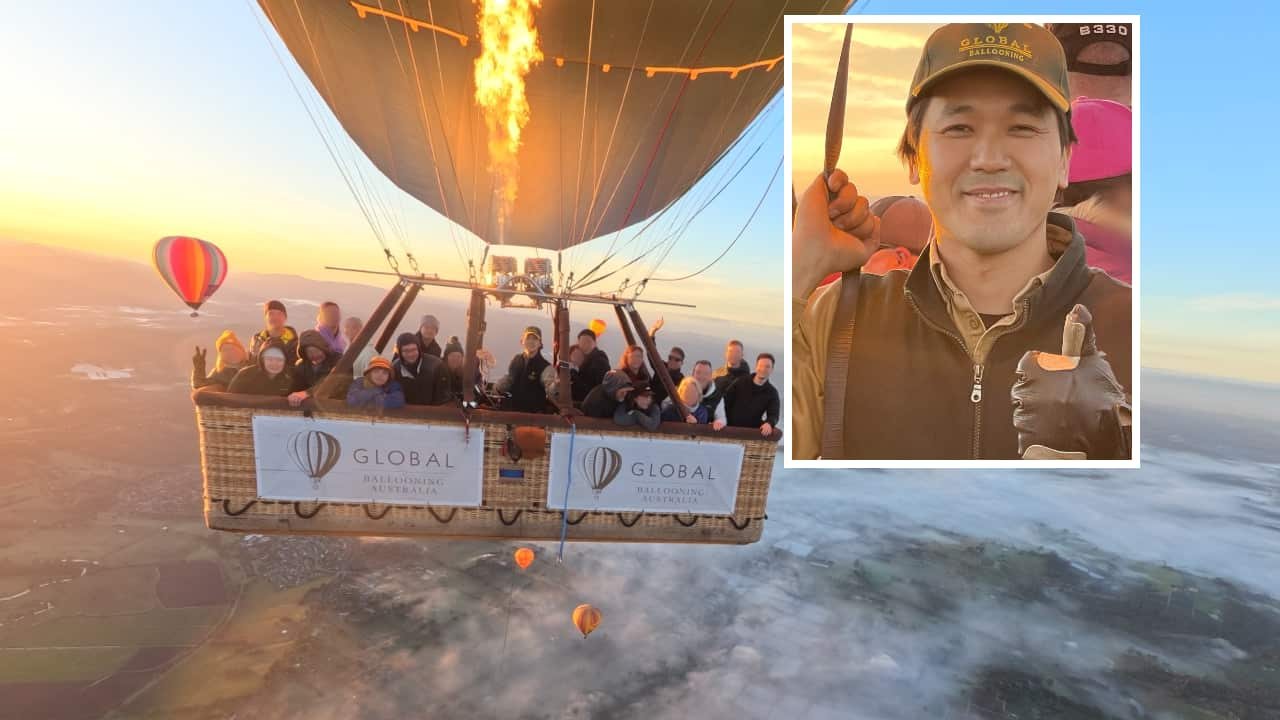Mr Ishihara says he was just three years old when he first rode in a hot air balloon, tagging along with his father as it was his hobby.
After that, he says he continued to ride hot air balloons as a hobby himself until he was 29 when he quit the company he was working for in Japan and came to Australia, determined to work as a professional hot air balloon pilot.

Credit: Sanshiro Ishihara
While he had always dreamed of taking passengers up in balloons, he says that in Japan, there was no such thing as a professional hot air balloon pilot licence for business. He says that his desire to work as a professional pilot was a main driver to him coming to Australia on a working holiday visa.

Credit: Sanshiro Ishihara
However, he says others warned him that he might not be able to get a job after returning to Japan, and that it would be difficult for him to learn English as he was turning 30.
Nonetheless, Mr Ishihara says he forged ahead with his dream and plan to not return to Japan.

Credit: Sanshiro Ishihara
Hot air balloons are classified as aircraft in Australia, but not so in Japan. Because he could not convert his ballooning experience into a licence in Australia, he says he needed to take the exam from scratch.
Mr Ishihara, who says that he could not speak English well when he first came to Australia, studied English while working at a Japanese restaurant and mowing lawns.

Credit: Sanshiro Ishihara
Australian customs sometimes confusing
He says not only learning English, but also having to absorb Australian customs had often left him feeling confused.
For example, he says Australian customs are very relaxed compared to Japanese senior/junior rules and other social rules regarding punctuality.
Because of these factors, he says he had a hard time getting used to the new culture at first, but knew he had to because he was the one who was coming from outside.
Mr Ishihara first obtained a job as hot air balloon ground crew whose task it is to prepare the hot air balloon with the pilot, drive a car with a long trailer to the balloon landing site after the pilot took off, and tidying up afterwards.
In addition, it is also a job that takes a lot of communication with customers. It's a popular job for locals who love balloons, but how did Mr Ishihara, who was still learning English at that time, get the hang of it?
Mr Ishihara says that he thought that he could not compete with local candidates because he was not a native English speaker.
Although he thought performing well on the job was the only way to catch up with them, Mr Ishihara had yet to be hired. So he says he shadowed a homestay friend who was working as ground crew every morning for three to four months, without getting paid. That's how he says he learned his job, and also showed his solid work ethic as well as building trust.

Credit: Sanshiro Ishihara
The pilot heats the air inside the balloon via a burner, so that the balloon rises and flies. As the temperature inside the envelope drops, the balloon will go down. So how can the hot air balloon, which only moves vertically, be propelled in a horizontal direction?
Put simply, it's a matter of manoeuvring the balloon up to where the wind is blowing in the desired direction and at the desired speed, according to Mr Ishihara.
Joy of 'moving with the wind'
"The hot air balloon only moves up and down, so basically it flies with the wind - I think it is a better expression that it is carried by winds. That means, even though the speed is fast, you don't feel the winds because it moves with them. It is an experience that you are moving forward without being hit by the wind while floating," he says.
"When the burner is inactive, there is almost complete silence. Although it is silent, the balloon itself moves with the wind at 60 to 70 kilometres an hour when it's fast. It travels with the wind silently together with the wind.
"You can see scenery without a window and while moving.
"I think it is the best attraction (of hot air ballooning)."

Credit: Sanshiro Ishihara
Next stop, Kenya
Mr Ishihara says he places great importance on doing things because he wants to and breaking away from what others consider as conventional or the norm.
It's extremely important to try to do what you love until you can't go any further.Sanshiro Ishihara
Mr Ishihara says: "Of course I was lucky and helped by many people, but in the end, I think that if you try with the feeling that you really want to do it, it will come true."
And from June, he says he is planning to work as a hot air balloon pilot in Kenya for about four months. Mr Ishihara says his ultimate plan is to pilot balloons in countries all around the world.






